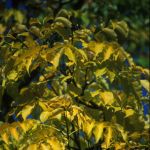| Common Name: |
Amur Cork Tree |
| Botanical Name: |
Phellodendron amurense |
| Genus: |
Phellodendron |
| Family Name: |
Rutaceae |
| Native Location: |
NE Asia |
| Cultivation: |
Rich, well-drained, neutral to alkaline soil in sun. Young growth may be damaged by late frosts in cold areas. |
| Propagation: |
By seed sown in autumn; by heeled semi-ripe cuttings in summer. |
| Harvest: |
Bark is stripped in winter and dried for use in decoctions. |
| Height: |
12-15m (40-50ft) |
| Width: |
15m (50ft) |
| Hardiness: |
Z3-9 |
| Parts Used: |
Bark (huang bai) |
| Properties: |
A bitter, diuretic, cooling herb that stimulates the liver and gall bladder, lowers fever, reduces blood pressure and blood sugar levels, and is strongly anti-bacterial. It acts mainly on the kidneys and is traditionally regarded as a detoxicant for hot, damp condition. |
| Medicinal Uses: |
Internally for diarrhea, dysentery, jaundice, meningitis, acute urinary tract infections, enteritis, boils, abscesses, night sweats, conjuctivitis, and skin diseases. An ingredient of the Chinese drug san huang zhe she ye ("injection of three yellow herbs"), the others being Coptis chinensis (See, Mishmi Bitter) and Scutellaria baicalensis (See, Bakail Skullcap). The drug is given intramuscularly for upper respiratory tract infections. |
| Bibliography: |
Encyclopedia of Herbs ~ Deni Bown ~ Copyright © 1995, 2001, Doring Kindersley Limited ~ pg. 311 |

